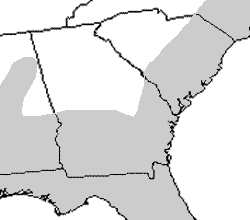Oak Toad (Bufo [Anaxyrus] quercicus)
Oak Toad (Anaxyrus quercicus)
![bufque210 Oak Toad (Bufo [Anaxyrus] quercicus)](https://srelherp.uga.edu/wp-content/uploads/sites/70/2024/01/bufque210.jpg)


Oak Toad Call
Description: The smallest North American toad, reaching only about 1.75 in (4.4 cm) in length. Easily identified by a distinct light mid-dorsal stripe, irregular brown and black dorsal spots, and proportionally large parotoid glands.
Range and Habitat: Restricted to the Coastal Plain of the southeastern United States. Most often found in open, sandy habitats such as longleaf pine and other southern pine forests. Commonly encountered beneath logs, leaf litter, or other woodland debris.
Habits: Unlike most toads, oak toads are primarily diurnal, often active during daylight hours. Breeding occurs in shallow, fishless pools formed by heavy rains. Males call from these sites using a distinctive, elongate vocal sac that extends dramatically while producing a high-pitched, chirp-like call.
Conservation Status: Generally common in suitable pine forest habitats, but populations are vulnerable to habitat alteration and the widespread loss of longleaf pine ecosystems.

